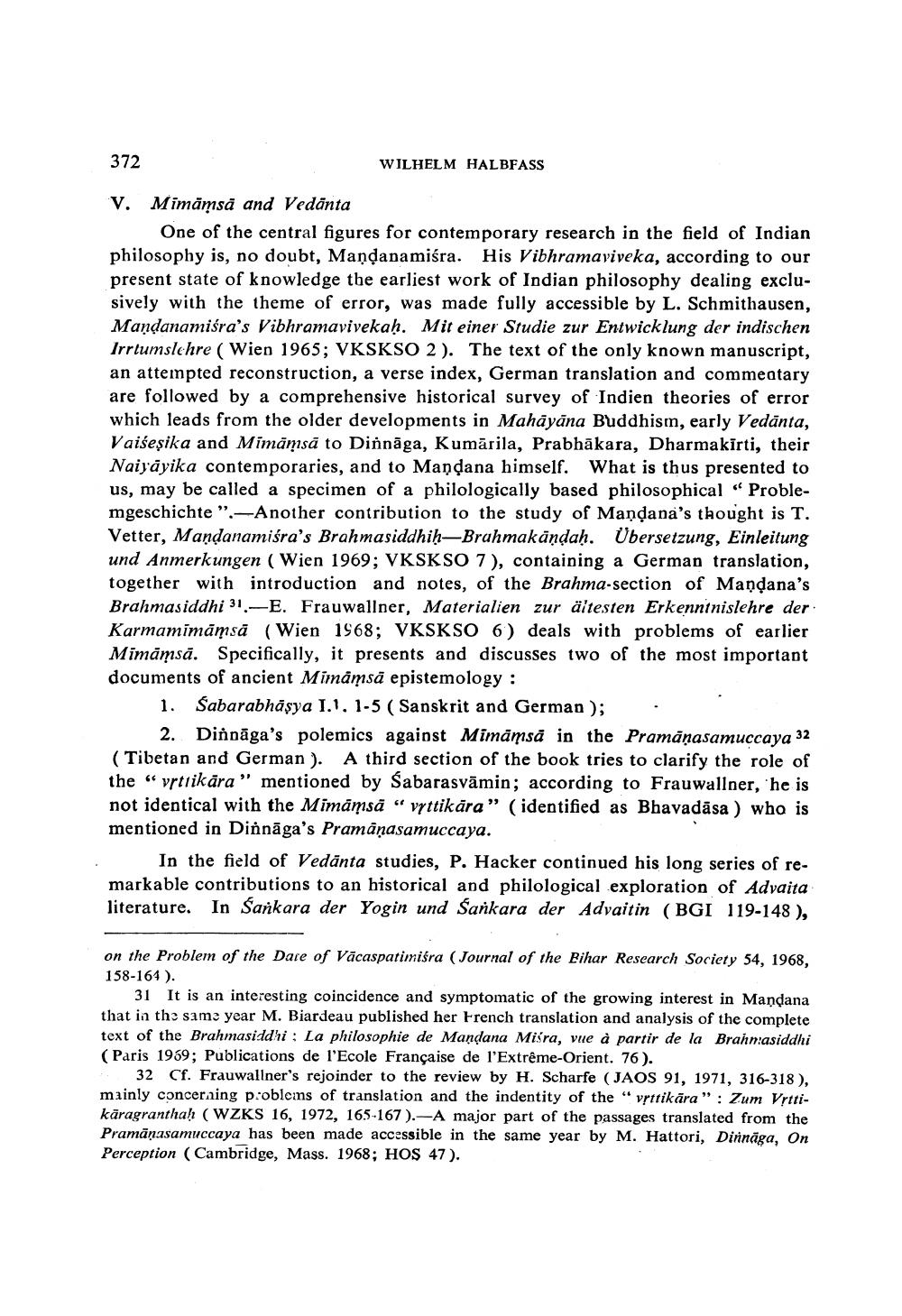________________
372
WILHELM HALBFASS
V. Mimämsä and Vedanta
One of the central figures for contemporary research in the field of Indian philosophy is, no doubt, Mandanamiśra. His Vibhramaviveka, according to our present state of knowledge the earliest work of Indian philosophy dealing exclusively with the theme of error, was made fully accessible by L. Schmithausen, Mandanamiśra's Vibhramavivekaḥ. Mit einer Studie zur Entwicklung der indischen Irrtumslehre (Wien 1965; VKSKSO 2). The text of the only known manuscript, an attempted reconstruction, a verse index, German translation and commentary are followed by a comprehensive historical survey of Indien theories of error which leads from the older developments in Mahayana Buddhism, early Vedanta, Vaiseṣika and Mīmāmsā to Diǹnāga, Kumārila, Prabhākara, Dharmakirti, their Naiyayika contemporaries, and to Mandana himself. What is thus presented to us, may be called a specimen of a philologically based philosophical "Problemgeschichte ".-Another contribution to the study of Mandana's thought is T. Vetter, Mandanamiśra's Brahmasiddhiḥ-Brahmakāṇḍaḥ. Übersetzung, Einleitung und Anmerkungen (Wien 1969; VKSKSO 7), containing a German translation, together with introduction and notes, of the Brahma-section of Mandana's Brahmasiddhi 31.-E. Frauwallner, Materialien zur ältesten Erkenntnislehre der· Karmamimāmsā (Wien 1968; VKSKSO 6) deals with problems of earlier Mimāmsā. Specifically, it presents and discusses two of the most important documents of ancient Mimämsä epistemology:
1. Sabarabhasya I.1. 1-5 (Sanskrit and German);
2. Dinnaga's polemics against Mimämsä in the Pramāṇasamuccaya 32 (Tibetan and German). A third section of the book tries to clarify the role of the "vrtlikära " mentioned by Sabarasvamin; according to Frauwallner, he is not identical with the Mimämsä "vrttikära" (identified as Bhavadāsa) who is mentioned in Dinnaga's Pramāṇasamuccaya.
In the field of Vedanta studies, P. Hacker continued his long series of remarkable contributions to an historical and philological exploration of Advaita literature. In Sankara der Yogin und Sankara der Advaitin (BGI 119-148),
on the Problem of the Dare of Vacaspatimiśra (Journal of the Bihar Research Society 54, 1968, 158-164).
31 It is an interesting coincidence and symptomatic of the growing interest in Mandana that in the same year M. Biardeau published her French translation and analysis of the complete text of the Brahmasiddhi: La philosophie de Mandana Misra, vue à partir de la Brahmasiddhi (Paris 1969; Publications de l'Ecole Française de l'Extrême-Orient. 76).
32 Cf. Frauwallner's rejoinder to the review by H. Scharfe (JAOS 91, 1971, 316-318), mainly concerning problems of translation and the indentity of the "vrttikära": Zum Vrttikāragranthaḥ (WZKS 16, 1972, 165-167).-A major part of the passages translated from the Pramanasamuccaya has been made accessible in the same year by M. Hattori, Dinnaga, On Perception (Cambridge, Mass. 1968; HOS 47).




